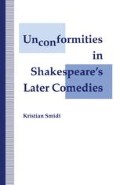Abstract
As we approach what is surely the unpleasantest of Shakespeare’s comedies, we can happily disengage ourselves from much of the discussion and controversy it has engendered. Measure for Measure is a play where it is easy to confuse moral and dramatic aspects, and they are not both, or both equally, our present concern. If we ask, ‘Was it right of Isabella to value her chastity above the life of her brother?’, or ‘Was the bed-trick devised by the Duke a defensible expedient in the circumstances?’, we are probably asking moral questions with theological and jurisprudential implications, which the play provokes but refuses to answer. We may also be thinking that the heroine should necessarily be seen as admirable, morally speaking. But we need not assume that either Isabella or her secret protector, the Duke, should be entirely admirable. It is more important that they should be credible in terms of the story. There has been a general tendency in the past to idealise Shakespeare’s comedy heroines indiscriminately, but it would be an exaggeration to call either Rosaline (of Love’s Labour’s Lost) or Hero or Helena or Isabella a paragon of sense and goodness.1
Access this chapter
Tax calculation will be finalised at checkout
Purchases are for personal use only
Preview
Unable to display preview. Download preview PDF.
Notes
It is generally agreed that the copy for the F text was Shakespeare’s ‘foul papers’ or ‘rough draft’ as transcribed by Ralph Crane, though Jowett argues strongly for prompt-book copy (Wells and Taylor, William Shakespeare: A Textual Companion, 1987, p. 468). Crane may have regularised speech prefixes and some other features. See the Arden MM (1965, 1976) pp. xi–xii, xxiv. Lever has listed and commented on most of the anomalies of MM in his Arden edition, pp. xiii–xxxi, lxvi; lxxix, lxxxii, lxxxvii, xc, xciv–xcvi.
Musgrove, ‘Some Composite Scenes in Measure for Measure’, SQ XV.1 (1964), pp. 67–74.
See also Leech A., ‘The “Meaning” of Measure for Measure’, SS 3 (1950), p. 68. Pettet finds ‘something peculiarly unsatisfying in the play’s treatment of evil’ and instances the deflation of ‘Angelo’s unbridled lust’ in the latter half of the play (Shakespeare and the Romance Tradition, 1949, 1970, pp. 157–8).
See also Rees, Shakespeare and the Story (1978), p. 58.
Thus Rossiter (Angel with Horns, 1961, p. 160),
Kirsch (‘The Integrity of “Measure for Measure”’, SS 28, 1975, p. 97), Rees (op. cit., 1978, p. 57).
Sexual inhibitions and neurosis are emphasised by Wilson Knight (The Wheel of Fire, 1930, 1960, p. 93) and
Hawkins (‘“The Devil’s Party”: Virtues and Vices in “Measure for Measure”’, SS 31, 1978, p. 112).
See Evans, Shakespeare’ s Comedies (1960), pp. 217–18. Tillyard rejects this idea of a moral education as represented by R. W. Chambers, even though, as he ironically remarks, ‘Nothing could be more ingenious and plausible than Chambers’s notion of Shakespeare’s keeping Isabella ignorant of her brother’s survival and filled with justified fury at Angelo’s having done him to death, in order that her powers of forgiveness might be tested to the uttermost when she brings herself to join Mariana in pleading for Angelo’s life’ (Shakespeare’ s Problem Plays, 1950, 1970, p. 121).
For the Christ-analogy and the Providential view of the Duke see e.g. Wilson Knight (op. cit., 1930, pp. 74, 79–82), Battenhouse (‘Measure for Measure and Christian Doctrine of the Atonement’, PMLA LXI, 1946, pp. 1029–59)
Toole (Shakespeare’s Problem Plays, 1966, p. 192), Kirsch (op. cit., p. 104). On the other side, e.g. Leech (op. cit., pp. 112–16) and
Weil (‘Form and Contexts in Measure for Measure’, CQ 12.1, 1970, pp. 61–7). A balanced view is that of Rossiter, who sees the Duke as the representative of ‘degree’ and order (op. cit., 1961, p. 156). This is not far from the view of the Arden editor (the Duke as ‘the representative of true secular and spiritual authority’), but Rossiter rejects (p. 156) Lever’s opinion that ‘the Duke belongs to quite another level of dramatic presentation than that on which the other characters act and suffer’ (Arden MM, p. xciv).
See also Lawrence, Shakespeare’s Problem Comedies (1931, 1969), pp. 105–7.
E.g. by Coghill, ‘Comic Form in Measure for Measure’, SS 8 (1955), pp. 23–4. See MM I.iv50–5, III.ii.85–90, 145–8, IV.iii.154–5. It should be observed that if Lucio did see through the Duke it would spoil the dénouement, in which Lucio is obviously unprepared for the Duke’s reappearance.
Author information
Authors and Affiliations
Copyright information
© 1993 Kristian Smidt
About this chapter
Cite this chapter
Smidt, K. (1993). The Divided World of Vienna. In: Unconformities in Shakespeare’s Later Comedies. Palgrave Macmillan, London. https://doi.org/10.1007/978-1-349-13063-4_6
Download citation
DOI: https://doi.org/10.1007/978-1-349-13063-4_6
Publisher Name: Palgrave Macmillan, London
Print ISBN: 978-1-349-13065-8
Online ISBN: 978-1-349-13063-4
eBook Packages: Palgrave Literature & Performing Arts CollectionLiterature, Cultural and Media Studies (R0)

